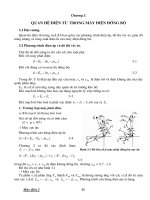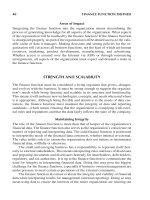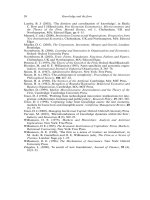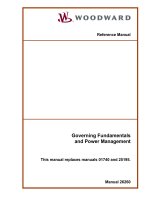Governing Fundamentals and Power Management phần 3 ppt
Bạn đang xem bản rút gọn của tài liệu. Xem và tải ngay bản đầy đủ của tài liệu tại đây (389.76 KB, 10 trang )
Manual 26260 Governing Fundamentals and Power Management
Woodward 15
Figure 3-3. Compensated Governor Schematic
The Droop Curve
Droop is a straight line function, with a certain speed reference for every fuel
position. Normally a droop governor lowers the speed reference from 3% to 5%
of the reference, from no load to full load Thus, a 3% droop governor with a
reference speed of 1236 rpm at no load would have a reference speed of 1200
rpm at full load.
If the linkage is changed, altering the amount of governor output shaft travel from
no load to full load, the droop must be reset. Be sure to use a least 2/3 of the
governor output shaft travel to ensure stability and allow sufficient droop range
adjustment.
Uses Of Droop
Isolated Unit
Most governors are capable of operating in the isochronous mode, However,
droop operation is necessary for many applications.
Governing Fundamentals and Power Management Manual 26260
16 Woodward
Figure 3-4. Comparison of 3% Droop
Speed Settings for 50% and 100%
Load
Figure 3-5. 3% and 5% Droop Curves
Isolated, single-engine applications can operate in either isochronous or droop.
In single engine applications, the engine operation is not affected by any other
engines or the utility. In isochronous operation, the speed returns back to the
original speed after a load has been applied up to 100% load. In droop operation,
the speed decreases by a set percentage after a load has been applied. In the
droop mode, if the original speed is desired, the operator must raise the speed
setting to return to the original speed when a load is applied.
Isolated Systems
An isolated system is an application where two or more engines are driving a
common load. This load could be electrical generators, pumps, ship propellers,
or combinations of these and any other mechanical loads. These isolated
systems are not connected to any other systems or to a utility.
Without some form of isochronous load sharing scheme like the electronic
isochronous load sharing control, droop must be used to share these loads.
The isochronous mode can also be used on one engine, running in parallel with
any other engine. However, unless the governors have isochronous load sharing
capabilities, no more than one of the engines running in parallel can be in the
isochronous mode. If two engines operating in the isochronous mode without
load sharing controls are supplying power to the same load, one of the units will
try to carry the entire load and the other will shed all of its load. In order for the
two units to share load, some additional means must be used to keep each
engine from either trying to take all the load, or from motoring.
Manual 26260 Governing Fundamentals and Power Management
Woodward 17
The reason for one unit taking all the load and the other unit dropping all the load
is shown in the following example:
If two isochronous units are to be coupled together on the same load and the
speed settings are not the same, the system will become unbalanced when
coupled together. Since there cannot be two different speeds on one system
coupled together, one engine will have to decrease its actual speed and the
other will have to increase its actual speed to an average speed between the
two. The governor on the engine that decreased speed will move to increase fuel
to try to correct for the decrease in speed, and the governor on the other unit that
increased speed will move to decrease fuel to try to correct for the increase in
speed. The result will be that the engine with the higher speed setting will
continue to take all of the load until it reaches its power limit, and the other
engine will shed all of its load and become motored (driven by the other engine).
As seen by the example, units running in isochronous cannot share loads without
an isochronous load sharing scheme.
Using Droop to Share Loads
If all engines in a droop system have the same droop setting, they will each
share load proportionally. The amount of load each carries will depend on their
speed settings. If the system load changes, the system speed/frequency will also
change. A change in the speed setting will then be required to offset the effect of
droop and return the system to its original speed/frequency. In order for each
engine in the system to maintain its proportion of the shared load, the operator
will need to adjust the speed setpoint equally for each engine.
If all engines in a droop system do not have the same droop setting, they will not
share loads proportionally with the same speed settings. If the system load
changes, the system speed/frequency will also change but the percent of load on
each engine-generator set will not be changed proportionately.
The operator will need to adjust the speed setpoint differently for each engine to
make them carry their proportional share of the load. This could result in running
out of speed setpoint adjustment on an engine before it is fully loaded and
limiting the system load sharing capability. It is best to have the same percent of
droop set on each engine (3% to 5% is recommended).
Figure 3-6. Droop Mode
Governing Fundamentals and Power Management Manual 26260
18 Woodward
Isolated Systems
Droop/Isochronous
Droop/Isochronous combines the first two modes. All engines in the system are
operated in the droop mode except for one which is operated in the isochronous
mode. It is known as the swing machine. In this mode, the droop machines will
run at the speed/frequency of the isochronous unit. The droop percentage and
speed settings of each droop unit are adjusted so that it generates a set amount
of power. The output power of the swing machine will change to follow variations
in the load demand while maintaining constant speed/frequency of the system
(see Figures 3-3 and 3-4).
Figure 3-7. Swing Machine
Maximum load for this type of system is limited to the combined output of the
swing machine and the total set power output of the droop machines. A load
above this maximum will result in a decrease in speed/frequency. The minimum
system load cannot be allowed to decrease below the combined output set for
the droop machines. If it does, the system frequency will increase and the swing
machine can be motorized.
The machine with the highest output capacity should normally be operated as the
swing machine so that the system will accept the largest load changes within its
capability. This is not a rigid rule. Selection of the swing machine will depend on
such things as efficiency of different engines and the amount the load is
expected to change.
Manual 26260 Governing Fundamentals and Power Management
Woodward 19
Figure 3-8. Droop Units
System Tied to a Utility Grid
Previously the use of droop has been discussed for systems that were isolated
(not tied to another larger system such as a utility). When an engine-generator
set is paralleled with a utility, there are a few things to consider:
• The utility will basically act as an isochronous unit. The utility will set the
speed/frequency for any units being paralleled to it. A simple isochronous
unit cannot be paralleled to the utility.
• When an isochronous engine-generator set is connected to a utility bus, the
utility will determine the speed/frequency of the generator. Should the
governor speed reference be less than the utility frequency, power in the
utility bus will flow to the generator and motor the unit. If the governor speed
is even fractionally higher than the frequency of the utility, the governor will
go to full load in an attempt to increase the bus speed. Since the definition
of a utility is a frequency which is too strong to influence, the engine will
remain at full load.
Droop provides the solution to this problem. Droop causes the governor speed
reference to decrease as load increases. This allows the governor to vary the
load with the speed setting since the speed cannot change.
Droop Base Load
Droop base load is the same as droop, with the exception that the utility or grid
will control the frequency and act as does the swing machine, absorbing any
change in load. The speed and droop settings are adjusted so that the engine-
generator set supplies a fixed, or base amount, of power to the utility (see Figure
3-7).
Governing Fundamentals and Power Management Manual 26260
20 Woodward
Based on 5% droop, increasing the speed setting to 61.5 Hz will produce 50%
power output. Following the droop line from the 61.5 Hz setting to the point
where it crosses the 60 Hz line (controlled by the utility) it can be seen that the
engine-generator set is at 50% power output. If the speed setting is increased to
63 Hz, the power output will be at 100%. Where the droop line crosses the utility
frequency line is the amount of power output produced. If the utility frequency
varies, the amount of output power will vary inversely. If the utility frequency
increases, the droop line will cross the higher utility frequency line closer to zero
power and produce a lower output or power. If the utility frequency decreases,
the droop will cross the lower utility frequency line farther from zero, producing a
higher output power. This condition is often mistaken for a governor problem,
which it is not.
Figure 3-9. Base Load with 5% Droop
If the engine-generator set is to be unloaded and disconnected from the utility,
simply decrease the speed setting slowly until the engine generator set is at
minimum power output, then open the tie breaker.
If the engine generator set is running in a loaded condition and the tie breaker
opens, separating the engine generator set from the utility, the frequency will
increase to the speed setting point. The amount the frequency increases
depends on where the speed setting was when the tie breaker opened.
Manual 26260 Governing Fundamentals and Power Management
Woodward 21
Figure 3-10. Schematic of Droop Governor
Governing Fundamentals and Power Management Manual 26260
22 Woodward
Chapter 4.
Linkage
General
Linkage between the governor output and the engine fuel control system is
responsible for many unacceptable control conditions that appear to be governor
connected. When acceptable governor control deteriorates or changes, linkage
is one of the first areas to troubleshoot. Loose or worn linkage not only can
cause unacceptable governor control, but it can also present dangerous
conditions should it fail completely and leave the engine uncontrolled. Good
locking methods must be used at all linkage connections.
There must be no lost motion or binding in the linkage attached between the
governor and the engine. Binding or “catches” in the linkage can cause speed
excursions and other problems which may appear as being caused by the
governor. Lost motion in the linkage will cause the governor to have to travel the
distance of the lost motion before any fuel change is made. The governor will
become over-active in fuel control. This overly active governor will provide less
than optimum control. An overactive governor will also cause excessive wear in
linkage and in the governor. The engine will tend to move up and down in speed
or wander.
Governor operation is based on the assumption that linkage is so arranged that a
given movement in the governor output will provide a proportional change in the
fuel to the engine.
Many fuel control systems provide a nearly linear response in engine output.
(This is usually true of diesel engines.) Other fuel control systems provide a
non-linear response to change in the control device position and engine outputs.
(This is particularly true of carbureted engines with butterfly valves.) All
governors tend to provide nearly linear travel. Differences between the linearity
of governor travel and the linearity in the engine fuel control system or valve are
accomplished by the design of the linkage between the governor and the engine
fuel system or valve.
Figure 4-1. Linear Fuel Control
Manual 26260 Governing Fundamentals and Power Management
Woodward 23
Figure 4-2. Non-Linear Fuel Control
Governor Travel
Design of the fuel linkage must provide for control of fuel from “FUEL OFF” to
“FULL FUEL” within the limits of the travel of the governor output shaft. The
design must also provide for about 2/3 output shaft travel between “NO LOAD”
and “FULL LOAD.” If less than 2/3 travel from no load to full load is not used, it
may not be possible to stabilize the engine. If a lot more than 2/3 travel from no
load to full load is used, there may not be enough travel to be sure the fuel is
shut off at minimum governor travel, and full fuel may not be reached at
maximum governor travel. This can make the engine appear sluggish. In both
cases, the misadjusted linkage can appear as a governor problem when it really
is not a governor problem.
Figure 4-3. Correct Use of Governor Travel
Governing Fundamentals and Power Management Manual 26260
24 Woodward
Linear Linkage Arrangements
This Linkage design provides a large amount of engine fuel motion for a small
amount of governor motion.
This Linkage design provides equal amounts of engine fuel motion and governor
motion.
This Linkage design provides a large amount of governor motion for a small
amount of engine fuel motion.
A linear linkage arrangement is used in applications where the governor output
shaft positioning is directly proportional to the torque output of the engine. A
linear linkage is a linkage design which provides as much movement of the
governor output shaft per increment of engine fuel movement at light loads as at
heavy loads.
Using less than the recommended amount of governor travel will provide
governor control which exhibits fast response and is, or tends to be, unstable.
Droop load sharing could be impossible if too little governor output shaft travel is
being used.
Using a lot more than 2/3 of the governor travel may not let the fuel system be
shut off or may not let the fuel system be opened to maximum.
The linkage must be set up to shut fuel completely off and let fuel be opened to
full fuel. Use at least 2/3 of the full governor travel from zero load to 100% load.









